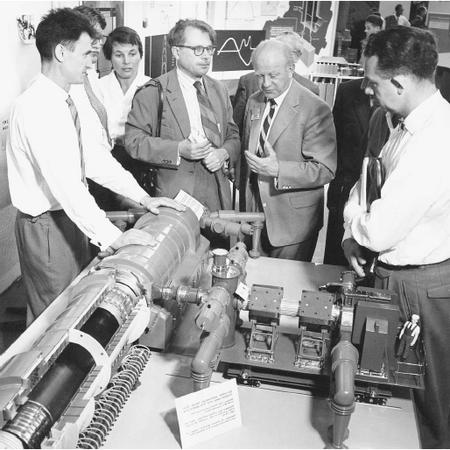Werner Heisenberg
GERMAN PHYSICIST
1901–1976
More so than any other physicist of the twentieth century, Werner Karl Heisenberg challenged our fundamental notions of the surrounding world. It could be argued that as the author of papers on quantum mechanics and the uncertainty principle, he nailed the coffin shut on the deterministic Newtonian version of the universe. Heisenberg replaced precision and accuracy with probabilities and uncertainties, and in so doing, he opened up the world of the subatomic to our understanding.

Born the second son of August and Anna Heisenberg, in Würzburg, Germany, Heisenberg demonstrated promise at an early age. At the age of nine, he entered the Maximilian Gymnasium in Munich where his maternal grandfather was headmaster. The curriculum emphasized classical languages and literature, but Heisenberg excelled in the minor subjects of mathematics and physics.
Heisenberg soon outgrew the limited curriculum; he studied Einstein's relativity on his own and taught himself calculus in order to tutor a college student for her final exams. For his final oral exams at the gymnasium, he solved the equations of projectile motion, taking into account air resistance.
His adolescence was set against the backdrop of World War I. Heisenberg participated in various youth movements and even joined a military training unit that helped to bring in the fall harvest before Germany surrendered. Food was scarce. The gymnasium was closed for long periods due to a shortage of coal. With most men serving in the military, Heisenberg and his fellow students were expected to continue their studies independently.
Heisenberg entered the University of Munich in the fall of 1920. His preparation at the gymnasium essentially earned him "junior year" status. The professor of physics at Munich, Arnold Sommerfeld, quickly recognized Heisenberg's potential, and it was not long before he was taking advanced classes. Indeed, he received his doctorate in 1923, at the young age of twenty-two, having studied with Max Born and listened to the Danish physicist Niels Bohr lecture at Göttingen.
A newly minted scientist, Heisenberg returned to Göttingen to serve as Born's assistant until the spring of 1926. It was in 1925 that he achieved his first breakthrough in quantum mechanics. In essence, Heisenberg realized that certain properties do not commute and the law of commutation does not always apply. In normal mathematics, the law of commutation says that 3 × 2 = 2 × 3 = 6 and the order of multiplication does not matter. However, in matrix algebra, commutation is not necessarily observed. The order of multiplication does matter and can produce quite different results. Heisenberg's solution to the problems facing Bohr's quantum model of the atom relied on matrix algebra and provided a different approach in which discontinuities could occur. At almost the same time, Erwin Schrödinger formulated an alternate version of quantum mechanics based on waves. Both competed for center stage, and this resulted in fierce academic debate because Schrödinger's quantum mechanics was more deterministic.
Heisenberg's response was his second major breakthrough: The uncertainty principle that places a limit on the accuracy with which certain properties can be simultaneously known. In particular, the simultaneous measurement of both the position and the momentum of a particle can be known only to h /4 π (with h as Planck's constant). One can measure the position of a particle to an infinite level of precision, but then its momentum has an infinite uncertainty and vice versa. This sets an absolute limit on human knowledge of the physical world and leads to the idea of quantum mechanical probability.
Heisenberg went on to say: "If one wants to be clear about what is meant by the 'position of an object,' for example, of an electron…, then one has to specify definite experiments by which the 'position of an electron' can be measured; otherwise this term has no meaning at all" (Cassidy, "Werner Heisenberg [1901–1976]"). In effect, reality does not exist until measured. This concept not only reformulated physics, but also had a major impact on Western philosophy.
Heisenberg received, among many other honors, the Nobel Prize in physics in 1932 for his formulation of quantum mechanics and its prediction of observable experimental facts. His work in all aspects of theoretical physics kept Heisenberg at the forefront of modern physics until he died of cancer in 1976.
SEE ALSO Bohr, Niels ; Quantum Chemistry ; SchrÖdinger, Erwin .
Todd W. Whitcombe
Bibliography
Cassidy, D. C. (1992). Uncertainty: The Life and Science of Werner Heisenberg. New York: W. H. Freeman.
Heisenberg, W. (1974). Across the Frontiers. Translated from German by Peter Heath. New York: Harper & Row.
Internet Resources
Cassidy, D. C. "Werner Heisenberg (1901–1976)." Available from http://www.aip.org/history/Heisenberg .
Nobel e-Museum. "Werner Heisenberg—Biography." Available from http://www.nobel.se .
Comment about this article, ask questions, or add new information about this topic: